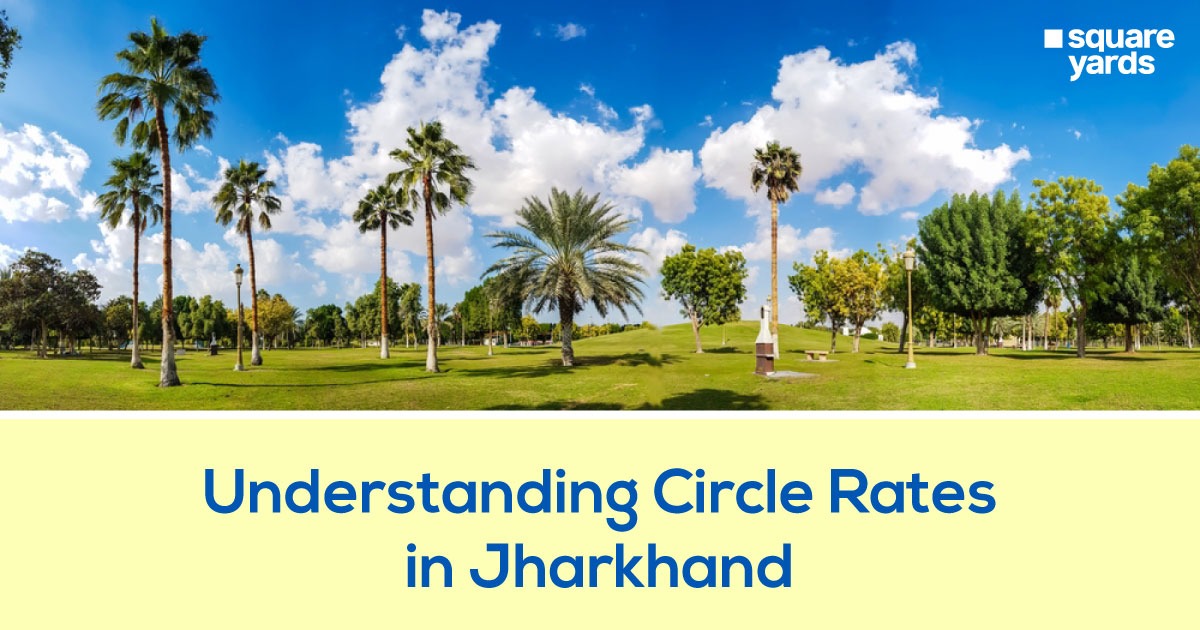In Jharkhand, understanding circle rates is crucial for both property buyers and sellers. The state government sets circle rates to prevent the undervaluation of properties during transactions. This ensures that the government secures the appropriate amount of stamp duty and registration fees, which are essential for fair and transparent real estate dealings. Circle rates are determined by considering various factors such as location, type of property, and available amenities. While these rates provide a baseline for property valuation in legal and tax-related contexts, they may not always align with the actual market values. This discrepancy can significantly impact property transactions and tax calculations. This influences both government revenue and individual financial obligations.
In this blog, we’ll explore the role of circle rates in Jharkhand‘s property market, examining their effects on stamp duty and registration fees and their implications for buyers and sellers in the state.
Table of contents
- What are the Jharkhand Circle Rates?
- How is the Circle Rate in Jharkhand different from the Marketplace?
- How do You Find Out the New Jharkhand Circle Rates?
- Circle Rates, Jharkhand – City-wise List
- 5 Factors that Affect the Valuation of Circle Rate in Jharkhand
- Latest News on Circle Rate, Jharkhand
- FAQ’s about Circle Rates in Jharkhand
What are the Jharkhand Circle Rates?
Circle rates are the lowest prices set by the government at which properties must be registered in a specific area. They are often referred to as guideline values or ready reckoner rates. In real estate transactions, these rates determine a property’s worth to determine stamp duty and registration costs.
How is the Circle Rate in Jharkhand different from the Marketplace?
The circle rate in Jharkhand and the marketplace rate (also known as the market value) differ significantly. Let’s explore these differences:
Circle Rate
The circle rate is the minimum value at which a property should be registered during its transfer.
It is determined by the state government’s revenue department or local development authorities.
Circle rates are reviewed periodically based on location, property type, and amenities. These rates are often conservative and may not reflect the actual market value.
Marketplace Rate
The marketplace rate represents the price at which properties are bought and sold in the open market. It considers supply, demand, location, infrastructure, amenities, and other market dynamics. Economic conditions, development projects, and buyer preferences influence the marketplace rate. Unlike circle rates, the marketplace rate can fluctuate significantly based on market trends.
Key Differences
Purpose: Circle rates are primarily used for property registration and taxation, while marketplace rates guide actual transactions.
Conservatism
Circle rates tend to be conservative, ensuring a minimum valuation for registration.
Market Dynamics
Marketplace rates are dynamic and responsive to market forces.
Discrepancies
In some cases, the marketplace rate may be much higher than the circle rate due to demand, location, or other factors.
How do You Find Out the New Jharkhand Circle Rates?
To find out the new circle rate in Jharkhand, you can follow these steps:
- Visit the official Jharkhand Revenue Department portal.
- On this portal, you’ll find a comprehensive list of circle rates for all lands in Jharkhand.
- The circle rate is the minimum value at which a property should be registered during its transfer.
Minimum Valuation Details: The circle rate is determined based on factors such as the district (SRO), aanchal, mauja, and property category.
Residential buildings are subject to a property tax of 0.075 per cent based on the circle rate, while non-residential or commercial properties pay a 0.15 per cent tax.
Circle Rates, Jharkhand – City-wise List
Below is the city-wise list of the circle rates in Jharkhand:
| Ranchi | ||
| Locality Name | Buy Rates | |
| Price range per square feet (INR) | Avg price per square feet (INR) | |
| Ormanjhi | 1,148 / sqft | 1,148.33 / sqft |
| Morabadi | 3,932 – 4,237 / sqft | 4,231.78 / sqft |
| Lalpur | 3,333 – 5,706 / sqft | 4,924.17 / sqft |
| Bariatu | 3,333 – 4,746 / sqft | 4,184.69 / sqft |
| Doranda | 2,791 – 4,500 / sqft | 4,500 / sqft |
| Argora | 4,609 / sqft | 4,608.7 / sqft |
| Ashok Nagar | 6,143 / sqft | 6,142.59 / sqft |
| Kokar | 3,700 / sqft | 3,700 / sqft |
| Namkum | 2,800 – 3,072 / sqft | 3,72.2 / sqft |
| Oyna | 3,497 / sqft | 3,496.86 / sqft |
| piska more | 2,963 / sqft | 2,962.96 / sqft |
| Bariatu Road | 4,077 – 4,235 / sqft | 4,235.29 / sqft |
| Hesag | 3,415 / sqft | 3,415.15 / sqft |
| Khatanga | 4,100 – 4,101 / sqft | 4,100.44 / sqft |
| Bargain Village | 4,694 / sqft | 4,694.17 / sqft |
| Karamtoli Road | 5,000 / sqft | 5,000 / sqft |
| Ekta Nagar | 4,117 / sqft | 4,117 / sqft |
| Dhanbad | ||
| Locality Name | Buy Rates | |
| Price range per square foot (INR) | Avg price per square foot (INR) | |
| Nawadih | 1,704 – 2,435 / sqft | 2,344.17 / sqft |
| Pandey Muhalla | 1,559 – 2,851 / sqft | 2,204.66 / sqft |
| Jagjiwan Nagar | 2,058 – 3,147 / sqft | 2,915.7 / sqft |
| Koyla Nagar | 2,083 – 5,000 / sqft | 3,541.67 / sqft |
| Jharudih | 2,262 / sqft | 2,261.9 / sqft |
| Anugrah Nagar | 2,300 / sqft | 2,300 / sqft |
| CCWO Colony | 2,933 / sqft | 2,933.33 / sqft |
| Karmik Nagar | 2,100 – 3,077 / sqft | 2,588.46 / sqft |
| Lohar Kulli | 2,667 / sqft | 2,666.67 / sqft |
| Saraidhella | 1,542 / sqft | 1,541.67 / sqft |
| Ashok Nagar Sector 2 | 2,304 / sqft | 2,304.35 / sqft |
| Binod Nagar | 2,769 / sqft | 2,769.35 / sqft |
| Chanakya Nagar | 2,823 / sqft | 2,822.58 / sqft |
| Kasitanr | 2,100 / sqft | 2,100 / sqft |
| Jamshedpur | ||
| Locality Name | Buy Rates | |
| Price range per square foot (INR) | Avg price per square foot (INR) | |
| Mango | 1,266 – 4,444 / sqft | 4,94.08 / sqft |
| Kadma | 2,778 – 6,087 / sqft | 5,500.64 / sqft |
| Adityapur | 1,656 – 4,954 / sqft | 4,624.21 / sqft |
| Sonari | 2,586 – 4,706 / sqft | 4,277.44 / sqft |
| Bistupur | 5,537 / sqft | 5,537.46 / sqft |
| Sonari Town | 3,000 – 4,150 / sqft | 3,774.93 / sqft |
| Telco Colony | 2,105 – 3,010 / sqft | 2,557.87 / sqft |
| Dimna Road | 2,350 / sqft | 2,350.43 / sqft |
| Parsudih Main Road | 2,244 – 3,111 / sqft | 2,622.22 / sqft |
| Gamharia | 2,783 – 3,225 / sqft | 3,77.54 / sqft |
| Parsudih | 2,100 – 4,869 / sqft | 3,659.89 / sqft |
| Sakchi | 6,007 / sqft | 6,6.6 / sqft |
| Bhalubasa | 2,889 / sqft | 2,888.89 / sqft |
| Govindpur | 3,333 / sqft | 3,333.33 / sqft |
| Baridih | 5,143 / sqft | 5,142.86 / sqft |
| Baradwari | 3,297 / sqft | 3,296.7 / sqft |
| Ghorabandha | 2,666 / sqft | 2,666 / sqft |
| Jamshedpur | 5,284 / sqft | 5,284 / sqft |
| Kapali | 3,193 / sqft | 3,193.28 / sqft |
| Uliyan | 3,360 / sqft | 3,360 / sqft |
| Adarsh Nagar | 3,818 / sqft | 3,818.18 / sqft |
| Bhatia Basti | 4,167 / sqft | 4,166.67 / sqft |
| Tamlia | 2,759 / sqft | 2,758.62 / sqft |
5 Factors that Affect the Valuation of Circle Rate in Jharkhand
These factors play a crucial role in determining the valuation of properties during registration:
Property’s Age
- The age of a property significantly influences its circle rate.
- Newer buildings typically attract higher rates compared to older ones.
- The rationale behind this is that newer constructions often incorporate modern amenities, better infrastructure, and improved quality of materials.
- Conversely, older properties may have wear and tear, outdated designs, or maintenance issues, leading to a lower circle rate.
Property’s Customization
- Customisation features offered by builders impact the circle rate.
- A property’s value increases with additional features or enhancements beyond the standard construction.
Examples of customisation include:
Upgraded Interiors: High-quality flooring, modular kitchens, designer fixtures, and premium finishes contribute to a higher circle rate.
Landscaping and Outdoor Amenities: Well-maintained gardens, swimming pools, and outdoor recreational spaces add value.
Smart Home Features: Properties equipped with smart home technology (home automation, security systems, etc.) command higher rates.
Energy Efficiency: Energy-efficient features like solar panels, insulation, and efficient HVAC systems positively impact valuation.
Additional Rooms or Spaces: Extra bedrooms, studies, or entertainment rooms increase the property’s worth.
Market Demand and Location
- The demand-supply dynamics in a specific area influence circle rates.
- Prime locations with good connectivity and proximity to commercial hubs, educational institutions, and recreational facilities tend to have higher rates.
- Areas experiencing rapid urbanisation or infrastructural development may witness an upward trend in circle rates.
- Conversely, less-developed or remote areas may have lower rates due to limited demand.
Latest News on Circle Rate, Jharkhand
Here are the latest news on the circle rate in Jharkhand:
New Property Tax Rules in Jharkhand
The Jharkhand government has approved a new law called the Jharkhand Municipality Amendment Bill 2022. This law changes how property tax is calculated in the cities of Jharkhand.
Main Changes
Property tax will now be based on the actual value of the property. The tax rate will be linked to the district administration’s land circle rate.
Previous System
Earlier, property tax rates were often based on old or random values. This was unfair and inaccurate.
New System
The property tax rate for residential buildings will be 0.075% of the circle rate, the minimum value the district administration sets for land.
Benefits
The new system ensures fairness and accuracy in tax calculations. Property owners will pay taxes based on the real value of their property. Local authorities can collect revenue more effectively.
Implementation
The district administration will enforce and monitor this change. Property owners should expect changes in their tax bills according to the new cycle rates. Property owners need to stay updated with these changes to follow the tax rules.
Key Takeaways on Circle Rate Jharkhand
Circle rates in Jharkhand are the minimum valuations the government sets for property registration and taxation, ensuring properties are not undervalued during transactions. These rates are periodically reviewed by the state government’s revenue department or local development authorities. It includes considering factors like location, property type, and amenities. Circle rates are often conservative and might not always reflect actual market values, leading to discrepancies in property transactions. Such differences can affect stamp duty, registration fees, and capital gains tax, influencing buyers and sellers. Recently, the Jharkhand government introduced changes in property tax rules, linking property tax to the circle rate for a fairer tax system based on actual property values. Understanding these rates is crucial for both property buyers and sellers in Jharkhand due to their impact on financial obligations and tax calculations.
Don’t miss it
FAQ’s about Circle Rates in Jharkhand
Q1. What is the Circle Rate in Jharkhand?
The circle rate in Jharkhand is the minimum value set by the government at which properties must be registered. It varies by location, property type, and amenities.
Q2. What is the resistance fee for the Jharkhand at the circle rate?
The registration fee for properties in Jharkhand is typically 3% of the property value, based on the circle rate.
Q3. Why should you know the circle rate before Investing in Property?
Knowing the circle rate helps estimate stamp duty and registration fees, ensure compliance with legal requirements, and understand potential tax liabilities.
Q4. Which part of Jharkhand is good for investment?
Ranchi, Dhanbad, and Jamshedpur are considered good for property investment due to their infrastructure, connectivity, and development potential.





